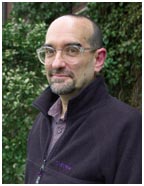
Photo by Frank Wojciechowski |
Jeffrey Stout *76
Over the years, religion professor Jeffrey Stout *76 has taught Princeton students about how faith is portrayed on the big screen, and he recently participated on a campus panel discussing Mel Gibson’s new film, The Passion of the Christ. This year, Stout is teaching Approaches to the Study of Religion, which incorporates materials ranging from the essays of David Hume to the films of Ingmar Bergman. He has a new book on the role of religious expression in a democracy. Stout spoke recently to PAW’s Mark F. Bernstein ’83.
What did you think of The Passion of the Christ?
I think there are two major spiritual, ethical problems that Passion films face, and the makers of great Passion films think hard about them. The first is the temptation on the audience’s part to want to scapegoat the people who are presented as being responsible for the suffering and death of the innocent party. The second is the temptation on the audience’s part to slip into a form of piety that is actually sadomasochistic voyeurism.
It’s pretty clear that Mel Gibson has not done enough to mitigate the dangers of an anti-Semitic reaction. It’s too bad that he worked harder on complicating the audience’s reaction to Pilate and his wife than he did on complicating the audience’s reaction to the most important Jewish characters. The other issue, sadomasochistic voyeurism, has received a lot less attention, but I think it is at least as important. The great Passion movies, such as Carl Dreyer’s silent film, The Passion of Joan of Arc (1928), use cinematic language to draw attention to the danger inherent in the very activity of focusing on another person’s pain and suffering. And it becomes a major theme in the work of director Alfred Hitchcock – himself a Catholic – in films such as Rear Window (1954) and Psycho (1960).
But isn’t the violence in Gibson’s movie intended to be a metaphorical expression of Christ’s taking on the sins of the world?
We have to keep in mind that this is a Hollywood director, and Hollywood influences are carried forward in his work. The two recent movies that matter most are Gibson’s 1995 film, Braveheart, which upped the ante significantly in the display of violence; and Steven Spielberg’s Saving Private Ryan (1998), in which Spielberg tried to address the pallid kind of patriotism that honors veterans by paying lip service to their sacrifice without really coming to terms with what the nature of their sacrifice was. It was an attempt to portray horror and violence in a way that refuses to let the audience look away in order to teach the magnitude of the soldiers’ sacrifice.
Isn’t there something about The Passion that makes it different from those other movies?
Braveheart is a story about revenge as an appropriate response to injustice and betrayal. Gibson’s The Patriot (2002) does the same thing. In the case of The Passion, we don’t have the explicit nationalist emphasis of Braveheart or The Patriot, but much of the rest of it is there. One would think that the Gospel message centers on the importance of unconditional love and forgiveness as opposed to vengeance. Gibson puts a little of this in, but the main experience of the movie is just the repeated experience of beating, whipping, and torture.
Does Gibson take liberties with the Gospels?
The Gospel accounts of the torture and beating of Jesus occur in just a couple of passages in Mark that have parallels in Matthew. Early Christian spirituality did not dwell on the suffering of Jesus to anything like the extent that it dwelt on the religious significance of his death and resurrection. So this movie takes material that is very slight and expands it through a massive use of religious imagination.
In your new book, Democracy and Tradition (2003), you sketch the proper role of religious discourse in a democracy. What is that role?
All citizens should feel free to express the premises on which they base their political conclusions as fully as they wish, consistent with civility and justice. But I take very seriously the First Amendment’s stress on the importance of prohibiting the establishment of a state religion. And I think that public officials, when they are speaking for the people, should be extremely cautious about implying that the people as a whole are religious in one way or another.
I got started by thinking about what was happening to people who would
have become civil rights activists if they had come of age politically
when I did, in the ’60s. It seemed clear that when they got to college,
most were exposed to a kind of liberal secularism that told them religion
was best kept completely out of public discourse. This caused two reactions.
A bunch became liberal secularists and suppressed whatever religious thoughts
might have brought them to the political process in the first place. Others
reacted negatively and became religious traditionalists. So the core of
my book is a detailed discussion of liberal secularism and the new forms
of religious traditionalism. I’m trying to articulate a vision of
democracy that will allow all citizens, religious and not, to feel like
full-fledged members who do not have to give up their own conception of
their integrity in order to participate. ![]()

